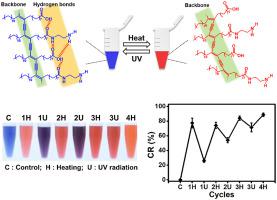Polymer ( IF 4.1 ) Pub Date : 2021-09-21 , DOI: 10.1016/j.polymer.2021.124211 Hee Yeon Sagong 1 , Min Hyeong Son 1 , Sa Hoon Min 2 , Yun Kyung Jung 1

|
Polydiacetylene (PDA) is an attractive material due to its unique chromatic transition properties by external stimuli. Its blue-to-red color transitions observed by the naked eye make the PDA a promising optical biosensor. However, the chromatic transitions of most PDA materials are irreversible, leading to restricted applications of PDA-based biosensors. In this study, we suggest that the colorimetric reversibility of PDA by the thermal-photo stimuli cycles is closely related to the difference in hydrogen bond strength and ionic interactions between adjacent headgroups of PDA vesicles. By fabricating three types of PDA vesicles consisting of single or complex headgroups, their reversibility in color change was compared. The PDA vesicles composed of both carboxyl- and amine-terminated monomers (poly(PCDA/PCDA-EDA)) at a molar ratio of 1:1 exhibited noticeable chromatic reversibility with colorimetric response (CR) values of 84–91% and 24–61% during heating and UV irradiation cycles, respectively. And, the reversibility of the poly(PCDA/PCDA-EDA) vesicles under different pH conditions was examined to assess the effect of ionic interactions. To investigate the changes in the backbone and strength of hydrogen bonds in the prepared PDA vesicles, Raman and Fourier transform infrared (FT-IR) spectroscopies were executed, respectively. These results demonstrate that the hydrogen bond strength and ionic interactions of PDA vesicles with different terminal functional groups plays an important role in “red to blue” backward transitions, which can ultimately be applied to the development of recyclable PDA materials.
中文翻译:

热光刺激下聚丁二炔囊泡的可控颜色变化
聚二乙炔 (PDA) 是一种有吸引力的材料,因为它在外部刺激下具有独特的色彩转换特性。肉眼观察到的蓝色到红色的颜色转变使 PDA 成为一种很有前途的光学生物传感器。然而,大多数 PDA 材料的颜色转变是不可逆的,导致基于 PDA 的生物传感器的应用受到限制。在这项研究中,我们认为热光刺激循环对 PDA 的比色可逆性与 PDA 囊泡相邻头基之间的氢键强度和离子相互作用的差异密切相关。通过制造由单一或复杂头基组成的三种类型的 PDA 囊泡,比较了它们在颜色变化方面的可逆性。PDA 囊泡由羧基和胺封端的单体(聚(PCDA/PCDA-EDA))组成,摩尔比为 1:1 表现出明显的颜色可逆性,在加热和紫外线照射循环期间,色度响应 (CR) 值分别为 84-91% 和 24-61%。并且,检查了聚(PCDA/PCDA-EDA)囊泡在不同 pH 条件下的可逆性,以评估离子相互作用的影响。为了研究制备的 PDA 囊泡中氢键的骨架和强度的变化,分别进行了拉曼和傅里叶变换红外 (FT-IR) 光谱。这些结果表明,具有不同末端官能团的 PDA 囊泡的氢键强度和离子相互作用在“红到蓝”向后转变中起着重要作用,最终可应用于可回收 PDA 材料的开发。











































 京公网安备 11010802027423号
京公网安备 11010802027423号